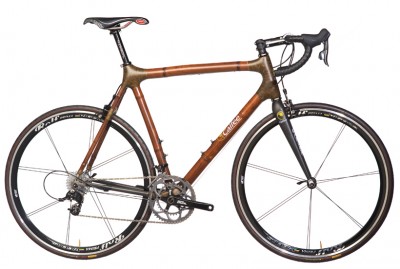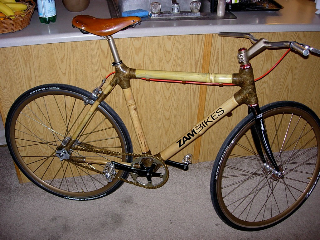Bamboo bicycles are something of a mystery. Up until a reader mentioned his skepticism about their durability on one of my recent blog posts, I hadn’t given bamboo much thought. Sure, I’d heard of such bikes. But, who other than a hippie would ride one?
Now, I know what you’re thinking: bamboo is an earth-friendly frame material which should be given consideration. I agree. There are good things about bamboo: it’s a member of the grass family and is abundant on all of the earth’s continents. It’s a renewable resource. It’s plentiful. It’s sturdy. Even so, riding a bamboo bicycle seems odd.
For the fun of it, I spent some time researching bamboo bikes. A few U.S. manufacturers offer bamboo high-end bikes. They are aimed at an upscale market of novelty seeking cyclists. Owning one of these bikes would certainly turn heads. They’re conversation starters. Something about them screams “exotic.”
One well-known manufacturer of bamboo bikes is Calfee Design. They describe their bikes as follows:
“Our frame is made from bamboo that has been smoked and heat treated to prevent splitting. We finish the bamboo frames with satin polyurethane that functions as a vapor seal and allows the owner to maintain the bamboo frame as they would any metal or carbon frame. Lugs are made of hemp fiber.”
Another U.S. company, Renovo Hardwood Bicycles builds wood and bamboo bikes. Their bamboo frames are made a bit differently: the bamboo is laminated. No specifics about this process are available on their website, but the laminated bamboo bikes look like wood. (I’m waiting for this small company to provide information about the laminated bamboo and will update this post as soon as it becomes available.)
Renovo Hardwood Bicycle’s Pandurban Commuter is described as follows:
“This Pandurban is built for commuting in the worst conditions Portland has to offer; rain, darkness, slush and traffic. The high-intensity LED headlight turns on automatically when you ride, and stays on several minutes after you stop. It has full fenders to keep the wet, mud and dirt at bay, and a serious, heavy-duty rack that sports a wide range of accessory top bags and panniers to carry as much stuff as you need. It’s available in caramelized laminated bamboo or hickory, with two drivetrain options.”
Both of these manufacturers offer a ten year warranty on their bamboo bikes. I’m not sure what to make of that. On one hand, they expect the bikes to last a decade. On the other hand, it makes me wonder about the long-term durability of the bikes. Some manufacturers of steel, aluminum, and titanium bikes offer lifetime warranties on their frames. With so few bamboo bikes on the road, it’s hard to gauge what to expect in terms of lifespan.
I asked Calfee Design about the durability of their bamboo bikes. No technical information was available. To determine bamboo’s durability they use only their experience/history and the resultant feedback. Confidence in its durability is measured by their offering an MTB model in bamboo, but not in carbon. Calfee’s representative said:
“Of the hundreds of bamboo frames we’ve sold to end-users since they were first offered in ’07 in our catalog, we haven’t seen any returned with damage from an impact (crash, etc). On occasion, bamboo can split. This is not owing to impact or stress but due to its “settling. That said, with our current crop of bamboo and our maturity in manufacturing frames in bamboo, we see very few failures.”
Bamboo bikes are relatively expensive. The base frame price for the Calfee road bike is $2,995. The Renovo Pandurban Commuter frame is $1495. These are certainly not bikes for the economically minded – although they look like works of art – and may be worth the price for those who appreciate finely crafted products.
As far as the ride goes, a review of Calfee’s bike said the following:
“We wouldn’t have guessed that bamboo could have the same level of damping as some of the best carbon bikes we’ve ridden, but it does. The Calfee has a great ride quality. The angles are steep enough to say race bike while the ride quality bespeaks the comfort of a touring bike. The Bamboo shone in fast, arcing turns. At just under 20 pounds, you can feel the weight. For some, the worst of it came on out of the saddle climbing sprints where they felt the bottom bracket was dragging on the ground.”
Outside of the U.S., especially in developing countries, bamboo bicycles play a different role. They can be crafted into inexpensive bikes for basic transportation. In countries where few people own cars, bikes can mean the difference between traveling outside a town and staying home.
Several companies have sprung up in Africa to meet the demand for bicycles. One is Zambikes:
“Zambikes is a social business that manufactures, assembles and distributes high quality bicycles, bicycle ambulances and cargo bicycle trailers to the underprivileged, empowering individuals to fight the mind set of poverty and address the economic and social needs of Zambia.”
The Bamboo Bike Project is another endeavor run by scientists and engineers at Columbia University’s Earth Institute.
“The ultimate goals of the project are:
1. To build a better bike for poor Africans in rural areas.
2. To stimulate a bicycle building industry in Africa to satisfy local needs.
We have determined that it is possible to source the material and supplies necessary to build a bamboo cargo bicycle in Africa, and train the local people to build the bikes.
The next steps are:
3. To setup systematic bamboo cargo bike building training.
4. To setup a supply chain of necessary parts and supplies.
5. To scale the effort so that it makes an impact”
Clearly, bamboo can serve as a way to improve the quality of life of people in rural areas and the projects mentioned above are worthwhile causes.
Somewhere in-between these two extremes is a middle ground. If the cost of purchasing a bamboo bike is too high, and you’re mechanically inclined, you can attempt to build one yourself. A Boston University student, Michael Mann, did just that. He couldn’t find step-by-step building instructions, so he improvised. It cost him around $800 to build the bike, but that’s a far cry from the thousands of dollars required to buy one. He talks about his experience with building a bamboo bike in the video below.
After my initial foray into the world of bamboo bikes, the primary deterrent to buying one is the question of lifespan. I like to keep a bike for a long time. Maybe when enough people have ridden these bikes and can provide real-world data on crash resistance, care requirements, and lifespan, I’ll cave in and purchase one myself.






One Response to Bamboo Bicycles: Exotic Luxury and Basic Transportation